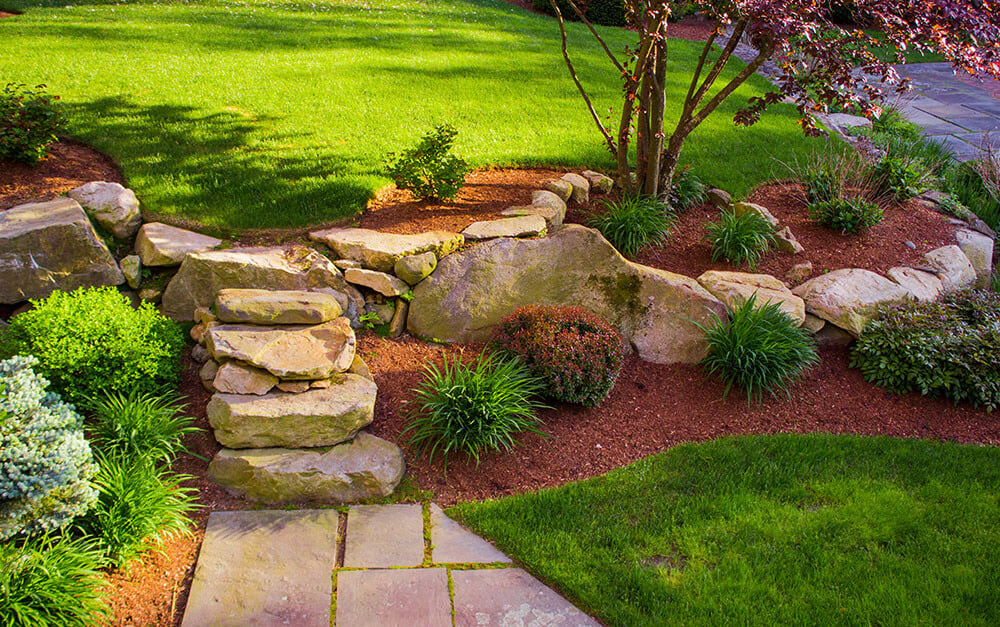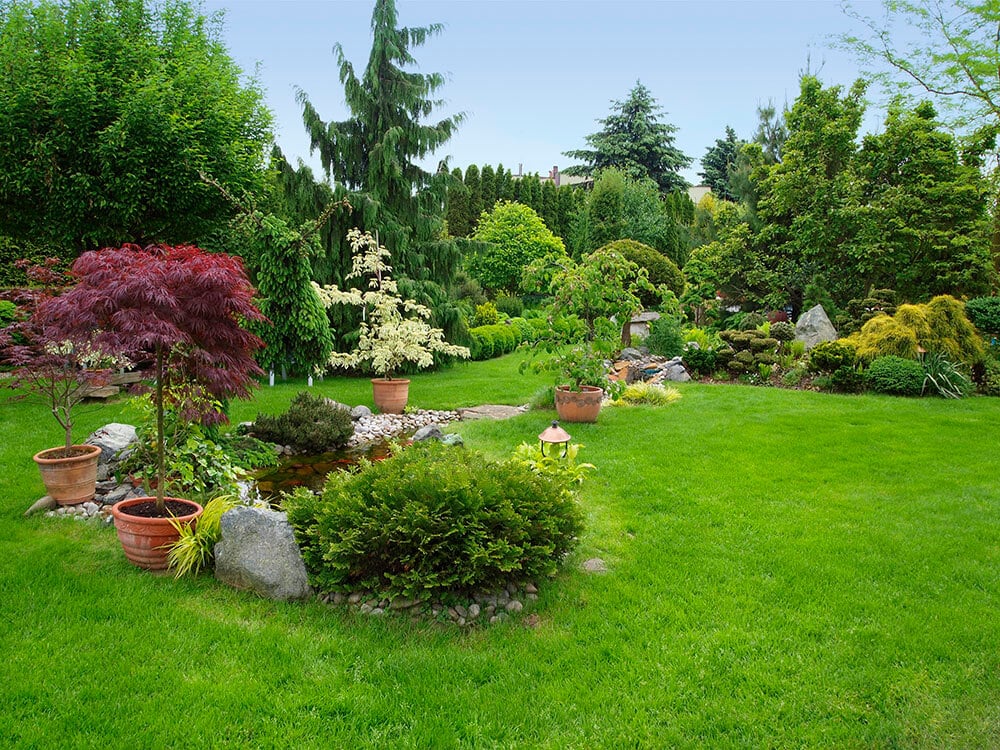10 Must-Know Yard Maintenance Tips, Whether You Own or Rent
Our yard maintenance mantra: Work smarter, not harder


Even if your yard is mostly patio or decking with a few plants in containers, you still need to perform some basic yard maintenance (sorry). Whether you're a homeowner or a renter, you want to enjoy your outdoor space, and that involves keeping on top of a few things throughout the year. Here’s what you or a pro should do to keep your yard in tip-top shape year-round.
Inspect Driveways, Patios, and Walkways
After a long winter, take a few minutes to inspect your driveway, patio, and walkways. Look for cracks, chips, raised pavers, or other damage. It's more cost-effective to correct minor damage as soon as you notice it rather than waiting for the issue to spread, becoming a bigger, more expensive job. For example, the cost to patch a small area of driveway yourself is $3 to $5 per square foot. But if you leave the small patch until you've got extensive driveway damage, an asphalt overlay will cost you up to $7 per square foot, and you'll need to have a much larger area covered.
After inspecting, perform any basic care and maintenance, such as pulling up weeds, basic patio cleaning, and maybe leveling a paver or two. In the winter months, freezing and thawing can cause pavers to shift, so you’ll want to keep an eye on that.
Best to do by: Early spring
Plant Trees, Shrubs, and Perennials
Plant trees, shrubs, and perennials after the threat of frost has passed. Planting in spring provides three full seasons for plants to develop strong roots and firmly establish themselves before they go into dormancy over winter. Just remember to water them regularly during drier spells while they're getting established.
Best to do by: Early-to-mid spring
Spruce Up Your Hardscaping
In early spring, it's time to clean or pressure wash the driveway, patio, decking, fencing, and pathways. Stain the fence, decking, and any other exposed wood once they're clean and dry. Sprucing up your hardscaping is a super-easy and effective way to breathe new life into your outdoor space.
Best to do by: Early-to-mid spring
Check Sprinkler and Irrigation Systems
When you're checking your drive and walkways, take the time to check your sprinkler and irrigation system, too. Rodents chew through hoses, a fallen limb breaks a pipe, or a sprinkler head or motor seizes up. A local lawn irrigation service will perform the inspection for you, and will also come back to properly shut your system off in the fall.
Best to do by: Mid spring
Fertilize Your Lawn
For lawns and garden beds, fertilizing in spring and fall is crucial. Apply a final feed of fertilizer to your yard in late fall, when it's stopped growing or grows so slowly it no longer needs mowing. For the best results, use a fertilizer high in nitrogen and potassium to encourage root growth, cold hardiness, and disease resistance. Once spring rolls around and the grass starts growing again, it's time to apply a slow-release fertilizer high in nitrogen (N), low in phosphorous (P), and moderate in potassium (K), so choose a fertilizer with an NPK of 20-5-10.
Best to do by: Early-to-mid spring and late fall
Build Soil Health
The foundation for all healthy outdoor spaces is healthy soil. And while soil health should always be at the front of your mind, you should schedule this essential yard maintenance in spring and fall. In fall, after you've removed the dead plants and harvested any tasty edibles, it's time to winterize the soil by tilling in (or digging in by hand—yikes!) lots of organic matter, like well-rotted manure or compost and mulched up leaves.
As it breaks down over winter, this matter releases nitrogen and other essential nutrients, replenishing the soil ready for the new plants in spring. Because it's fibrous and sometimes woody or contains straw, manure and compost improve soil structure and drainage—particularly useful if your garden soil is heavy. In spring, apply a top-dressing shortly before or just after you make your early plantings.
Best to do by: Early-to-mid spring and late fall
Reseed Dead Areas
Suppose you've noticed dead patches of grass appearing over the summer. In that case, the best time to repair and reseed your lawn is in early fall, when there's still time for the new grass to germinate and establish roots.
Ideally, dethatch or aerate the area first so that the grass seed can more easily reach the soil. Then seed, apply a top dressing, water regularly, and wait for the dead patch to transform into a lush, green lawn. If you need to dethatch and reseed a larger area, you can always hire a local lawn service to take care of it for you.
Best to do by: Early fall
Invest in Landscaping and Hardscaping

Winter is too cold and the ground's too hard, spring is too busy with all the other yard tasks, and summer is just too darn hot. So fall is the best time to take care of landscaping and infrastructure projects like building a deck or a patio, adding new raised beds, putting up a shed or a summerhouse, or installing a water feature
Best to do by: Early fall
Clear Up Old Organic Matter
As tempting as it might be to just let last year’s leaves, dead plants, and fallen fruit rot back down into your yard, it's not a good idea. This kind of organic matter harbors all kinds of pests and their larvae, keeping them well-fed and snuggly warm all winter until they emerge and gleefully munch their way through the plants you spend so long tending.
Old organic matter also plays host to fungal spores, molds, and plant pathogens, so leaving it lying around is the quickest way to make your plants sick.
Instead, in fall, get your rake out and clear away all the leaves and fallen debris. You can compost much of it, or bag the leaves up and let them decay, then use them as nutrient-rich leaf mulch in a year or two.
Best to do by: Late fall
Clean, Sharpen, and Service Tools and Equipment
When you're certain you've finished with your tools and machinery until spring, don't forget to winterize them. Drain fuel from gas lawnmowers, scrape away all the old, stuck grass cuttings, give the blade a little TLC, and take care of the engine, too. Here's a summary of how to winterize your lawnmower (and you can apply many of the same steps to your other yard equipment):
Drain fuel
Remove battery
Remove and clean sparkplugs
Replace or clean air filter
Change oil
Clean cutting deck
Sharpen blade
Clean and lubricate engine
For tools like forks, spades, and hoes, clean them down with hot soapy water, dry them thoroughly, then sharpen them. For tools with wooden handles, condition the wood by applying linseed oil.
Best to do by: Late fall or early winter
Year-Round Yard Maintenance Tips

Mowing Tips
Whenever you mow the grass, it can actually be quite stressful for the individual blades. To minimize damage and keep your grass green, never cut more than one-third of the grass’s height at a time. Any more than this and you'll shock the plants, leaving them susceptible to heat damage and pathogens.
When mowing for the first time in spring, set your mower to the highest setting so that you take only a small amount off the top of the lawn. Then, over the next few mowings, gradually lower the cutting height until the yard is at your desired length.
Weeding Tips
For the best chance of getting the roots of troublesome weeds out, wait until the ground is soft. Take care of as much weeding as you can in spring, before the ground dries out and bakes hard in the heat of summer. In areas that you know are problem spots, consider applying mulch to give nutrients to the soil and suppress weeds.
Watering Tips Through the Year
In early spring and late fall, make sure you water after the last trace of frost has gone and the garden has warmed a little—usually around midmorning. In hot weather, water in the early morning. If you water in the late evening, you encourage slugs and snails. Drip irrigation hoses are a great choice, as they deliver water little and often and don't splash on your plants, helping to lower the risk of soil-borne pathogens and fungi. For the lawn, a simple sprinkler system works well and requires little effort from you.





- Landscapers
- Tree Surgeons
- Gardening Services
- Landscape Architects
- Sod Installation
- Tennis Court Contractors
- Landscape Design
- Retaining Wall Companies
- Grading Companies
- Landscape Rock & Sand Delivery
- Mulch Delivery Services
- Pond Companies
- Artificial Grass Companies
- Shrub Removal & Trimming
- Backyard Design Companies
- Commercial Landscaping
- Koi Pond Services
- Backyard Landscapers
- Trampoline Assembly
- Hedge Trimming
- Pond Services
- Garden Design
- Outdoor Plant Watering
- Putting Greens
- French Drains
- Turf Installation
- Sod Removal Services
- Lawn Repair Services
- Brush Chipping Services
- Hardscape Contractor
- Landscape Rock Removal
- How to Prepare Your Lawn for Winter: 10 Important Tasks to Do
- 9 Fall Lawn Care Tips for a Healthy, Thriving Yard
- 12 Early Spring Landscaping Tips to Prepare Your Lawn and Garden
- 13 Essential Landscaping Tips for a Beautiful Spring Garden
- 13 Fall Gardening Tips for a Beautiful Spring Bloom
- 12 Tips for Taking Care of Your Backyard, From Pruning to Weed Prevention
- 13 Summer Landscape Tips That’ll Keep Your Grass Green and Plants Thriving
- 10 Fall Home Improvement Projects to Tackle This Year
- How to Spruce Up Your Existing Garden by Adding New Plants
- Spring Lawn Care: 15 Easy Steps to a Beautiful Yard
















